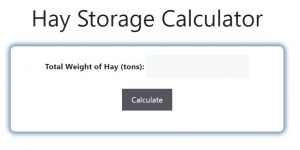About Hay Storage Calculator (Formula)
The Hay Storage Calculator is a valuable tool for farmers and agricultural workers who need to determine the optimal storage capacity for hay bales. Proper storage of hay is crucial for maintaining its quality and preventing spoilage. By calculating the required storage capacity, you can efficiently utilize space in barns, sheds, or outdoor areas, ensuring that your hay remains in good condition for feeding livestock.
Formula
The formula to calculate storage capacity is:
Storage Capacity = Number of Bales * (Length * Width * Height)
Where the Number of Bales refers to the total number of hay bales you intend to store, and Length, Width, and Height are the dimensions of each bale.
How to Use
Using the Hay Storage Calculator is straightforward:
- Gather Information: Measure the dimensions of a single hay bale (Length, Width, Height) and determine how many bales you plan to store.
- Input Values: Enter the number of bales and the dimensions into the calculator.
- Calculate: Click the calculate button to find out the total storage capacity required for your hay bales.
Example
Let’s assume you have the following details for your calculation:
- Number of Bales: 50
- Length: 1.2 meters
- Width: 0.6 meters
- Height: 0.5 meters
Using the formula:
Storage Capacity = 50 * (1.2 * 0.6 * 0.5)
Storage Capacity = 50 * 0.36
Storage Capacity = 18 cubic meters
In this example, you would need a storage capacity of 18 cubic meters to accommodate 50 hay bales.

FAQs
- What is a hay storage calculator?
A hay storage calculator determines the amount of space needed to store hay bales based on their dimensions and quantity. - Why is proper hay storage important?
Proper storage prevents spoilage, maintains nutritional quality, and protects hay from moisture and pests. - What dimensions are typically used for hay bales?
Common dimensions for hay bales can vary, but they often measure around 1.2m x 0.6m x 0.5m. - How do I measure the dimensions of a hay bale?
Use a tape measure to determine the length, width, and height of the bale. - Can I use the calculator for different types of bales?
Yes, the calculator can be used for various bale types, such as square or round bales, as long as you input the correct dimensions. - How does moisture affect hay storage?
High moisture content can lead to mold and spoilage, so it’s essential to store hay in a dry, well-ventilated area. - What factors should I consider when choosing a storage location?
Consider factors like ventilation, accessibility, protection from moisture, and temperature when selecting a storage site. - Can I stack hay bales?
Yes, but ensure they are stacked securely and not too high to prevent them from falling over. - What happens if I underestimate storage capacity?
Underestimating capacity may lead to overcrowding, which can cause damage to hay bales and reduce airflow. - How often should I check my hay storage?
Regularly inspect stored hay for signs of moisture or pest damage, ideally every few weeks. - Is there an ideal temperature for hay storage?
Aim for a cool, dry environment; temperatures between 20-25°C (68-77°F) are generally ideal. - What is the best way to prevent pests in hay storage?
Use sealed containers or treat the storage area with pest deterrents to minimize infestation risks. - How long can hay be stored?
Well-stored hay can last for several months to a few years, depending on conditions and quality. - What should I do if my hay gets wet?
Remove wet hay from storage immediately and allow it to dry properly before re-storing. - Can the calculator help with other crops?
While designed for hay, the principles can apply to other bulk crops; just adjust dimensions accordingly. - Are there any specific storage methods I should know about?
Options include storing hay in barns, sheds, or using tarps for outdoor storage; consider ventilation and moisture control. - How can I ensure optimal airflow in storage?
Leave space between bales and avoid packing them too tightly to allow air circulation. - What is the impact of temperature fluctuations on stored hay?
Temperature changes can lead to moisture buildup, increasing the risk of spoilage and mold. - Is it possible to rent storage space for hay?
Yes, many farms offer rental space, which can be a good option for those needing temporary storage. - What tools can help in measuring storage space?
A measuring tape and possibly a level are useful tools for ensuring accurate measurements of both hay bales and storage areas.
Conclusion
Using a Hay Storage Calculator is essential for optimizing your hay storage needs, ensuring you maintain the quality and integrity of your hay bales. By accurately calculating your required storage capacity, you can make informed decisions about your storage solutions, protect your investment, and ultimately support the health and productivity of your livestock. Regular monitoring and proper management practices will ensure that your hay remains in excellent condition for feeding and other uses.